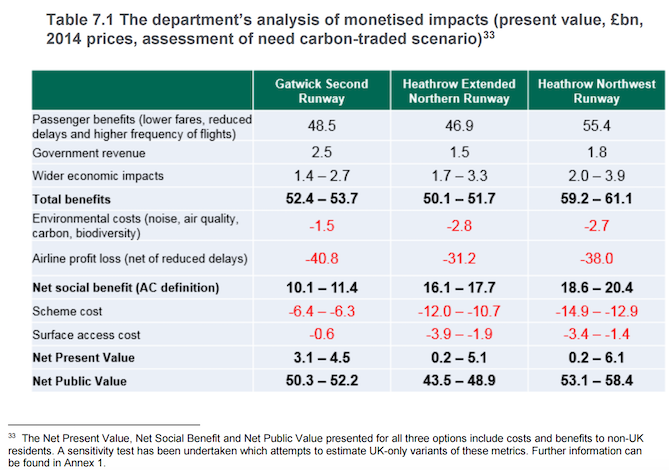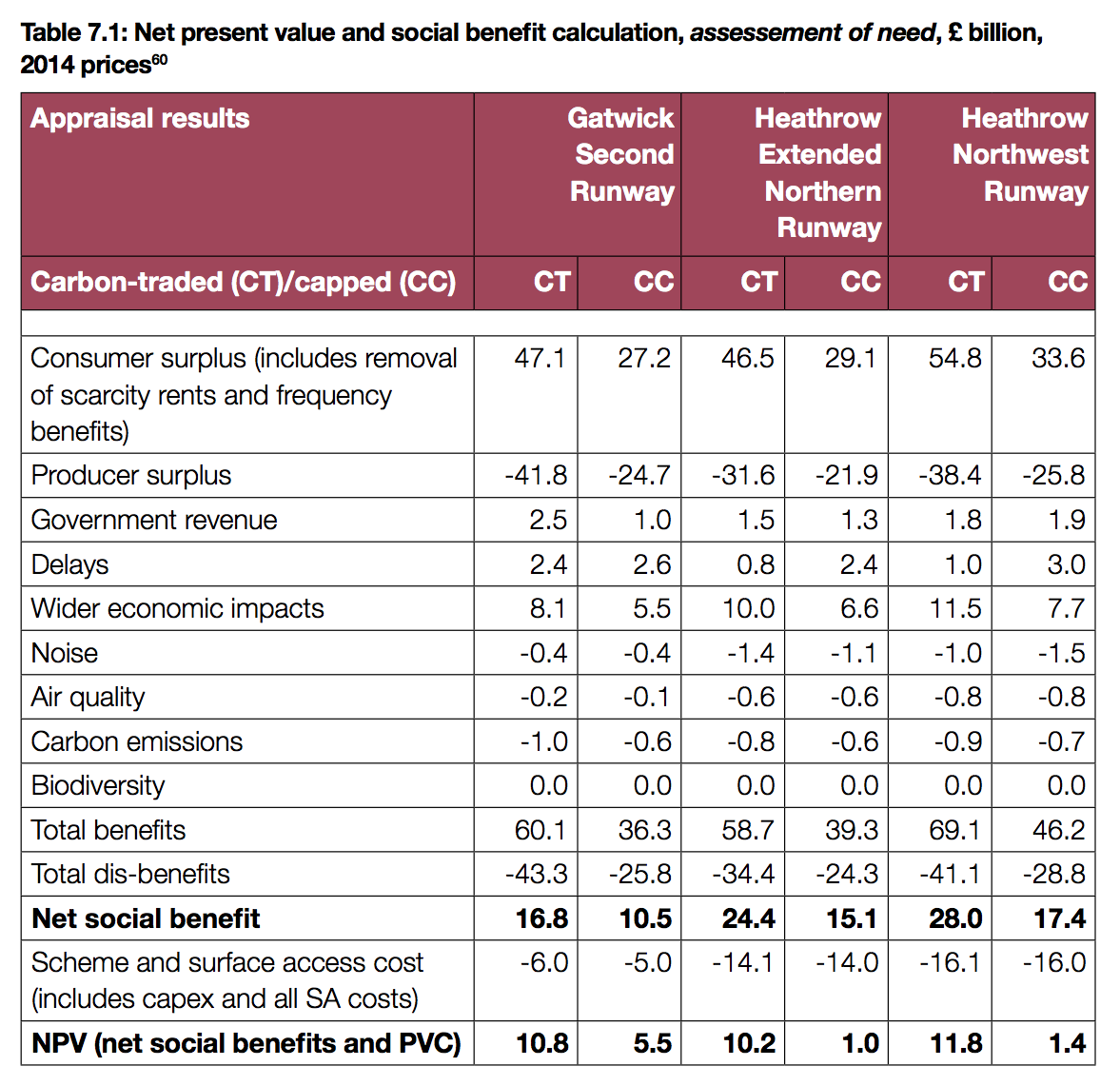DfT’s own study reveals just how tiny the possible economic benefits of Heathrow or Gatwick runway would be to UK
The economics figures by Airports Commission were always dubious, and their methodology was questioned by their own advisors. The Commission did not use the Webtag method that is normally used to cost transport projects. The Commission added in a range of possible future benefits for Heathrow, and for Gatwick – most purely speculative. Benefits of trade were added, even though these were effectively double counted as already taken account of by other sectors. The AC also counted in economic benefits to non-UK residents of flights to or from the UK. The recent DfT document entitled “Further Review and Sensitivities Report – Airport Capacity in the South East” has had to look more carefully at the figures. It has removed some of the wild claims of benefits from trade, and has looked at the benefits just to UK passengers. Its figures show little difference in the alleged future economic benefit to the UK between Heathrow and Gatwick, and that these benefits are actually tiny. Even when measured over 60 years. The DfT document mentions a large number of the aspects they looked at as being of “low analytic assurance”, meaning very uncertain. The new DfT figures give the total benefit (NPV) of a Heathrow north west runway being just £0.2 – £6.1 billion over 60 years, and the figure for Gatwick being £3.1 – £4.5 billion. The equivalent figures by the Airports Commission were £11.8 billion and £10.8 billion for Heathrow and Gatwick respectively. So current estimates are all even lower than before.
.
Tweet
The figures from the new DfT analysis for the NPV for all the UK of the Heathrow north-west runway, excluding Wider Economic Impacts, are only from minus (yes, minus) – £1.8 billion, up to plus £2.3 billion, over 60 years.
The NPV figure for a Gatwick 2nd runway would be plus £1.7 – £1.8 billion, over 60 years.
Government’s own study reveals Heathrow third runway would be less beneficial to UK residents than Gatwick
By JOE MURPHY (Evening Standard)
A bombshell Government study found Heathrow’s third runway would not benefit British residents as much as a second runway at Gatwick, the Evening Standard can reveal.
The cost-benefit analysis concluded that when benefits to overseas travellers and firms were excluded, British people and firms could gain up to £4 billion more in advantages if rival Gatwick was chosen for expansion.
The findings of the study – conducted by Department for Transport (DfT) officials using standard Whitehall methods – were buried in the annexe to a report published when Transport Secretary Chris Grayling announced Government backing for the third runway.
The full report went to the decision-making Cabinet committee chaired by Theresa May, said the DfT, but it was not circulated to the full Cabinet when members held its own debate on airport expansion a week earlier.
Anti-third runway campaigners said the disclosure left the economic case for Heathrow “in tatters”.
Former Cabinet minister Theresa Villiers [who wants a Gatwick runway] said: “It’s astonishing that Ministers could have signed off on this project when even the Government’s own figures say Gatwick is the better option for UK residents.”
In his Commons statement last week, Mr Grayling said Heathrow’s north- west third runway plan was chosen because it offered “the largest benefits to passengers and the wider economy, of up to £61billion over 60 years”.
However, the Further Review and Sensitivities Report makes clear that these benefits include impacts outside the UK as well as the value to overseas travellers using Heathrow as a hub to pass through.
When the UK-only benefits were calculated, they estimated that a third runway would bring benefits of between £5.8 billion and £9.9 billion. But they predicted Gatwick expansion would be worth £8.9 billion to £10.3 billion to U.K. residents. [See Table A 17].
Below is Table A 17 (NPV means Net Present Value and WEI means Wider Economic Impacts. All these figures are for all the UK, over 60 years).

[The DfT also said:
As shown in Table A 17, the UK-only NPVs are higher than the NPVs estimated under the central case for all of the options. This is because many of the costs of expansion – lower profits and construction costs – ultimately fall to airlines (and/or their passengers), many of whom are defined as being non-UK. 67 These NPVs should be seen as no more than indicative because of the difficulties in robustly apportioning both the costs to airlines and expansion construction costs, and as such are of low analytical assurance. On balance, the department’s view is that 66 The reasons for why this approach is appropriate in the case of aviation appraisal are discussed in the AC’s approach of including impacts to both UK and overseas residents is the most appropriate and internally consistent approach.”]
Other startling findings from the detailed report include:
Mr Grayling’s case for a third runway included an estimate for the extra costs of road and rail links to Heathrow as being just £3.4 billion or less – a much smaller sum than the Airport Commission estimate of over £5 billion and Transport for London’s claim that they could cost farepayers £10 to £15 billion. [Or up to £18 billion].
An overrun in Heathrow’s costs of just 1% could be enough to negate the overall benefits of the scheme. By contrast the analysis found Gatwick, which would cost half as much, would still offer benefits if costs rose by 44%.
The UK-only figures did not form part of the DfT’s central case for a third runway because, according to officials, they should be seen as “no more than indicative” and were “of low analytical assurance”. [Most things looked at in the DfT paper come out as of low or medium analytical assurance – which presumably means they are highly uncertain. AW note]
But Zac Goldsmith, who is fighting a by-election to protest at the third runway plan, said: “The case for Heathrow is falling apart before our eyes.
“Yesterday it became apparent it would fall foul of air quality requirements. Today we see the economic benefits to British people are much smaller than offered by Gatwick. The Government has been herded into a quagmire by vested interests. They need to step back.”
John Stewart, of anti-expansion group Hacan, said: “It seems the Government has put the interests of hub passengers changing planes at Heathrow before anything else.”
However a DfT spokesman insisted: “Heathrow offers the greatest benefits. The independent Airport Commission report was very clear that it is the best scheme.
“The central case of our report also shows the benefits of Heathrow are higher than for Gatwick with Heathrow expansion estimated to benefit passengers and the wider economy by £61billion and could create up to 77,000 jobs and 10,000 apprenticeships by 2030.” [The DfT’s own report says local jobs by 2030 are more likely to be up to 37,740 – but they persist in using the earlier 77,000 figure. Chris Grayling is happy for the DfT to continue to use the wrong figure. AW note]
.
Comparing tables between the DfT new paper and the Airports Commission Final Report
The table showing NPV (Net Present Value) for the 3 runway schemes, from the new DfT document. Page 39

By contrast, the almost equivalent table from the Airports Commission Final Report P147

The DfT no longer bothers with the carbon-capped case, saying it is unrealistic for the UK to limit its aviation carbon emissions to its current cap of 37.5MtCO2. So the new DfT document contains only carbon traded assessments.
The new DfT table shows economic benefit, (NPV) across the whole of the UK over 60 years as only £0.2 to £6.1 for the Heathrow north west runway. (The AC figure was £11.8 billion)
The new DfT table shows economic benefit, (NPV) across the whole of the UK over 60 years as only £3.1 to £4.5 for the Gatwick 2nd runway. (The AC figure was £10.8 billion)
.
Wider Economic Impacts are discussed on Page 30 of https://www.gov.uk/government/uploads/system/uploads/attachment_data/file/562160/further-review-and-sensitivities-report-airport-capacity-in-the-south-east.pdf
.
.
.
